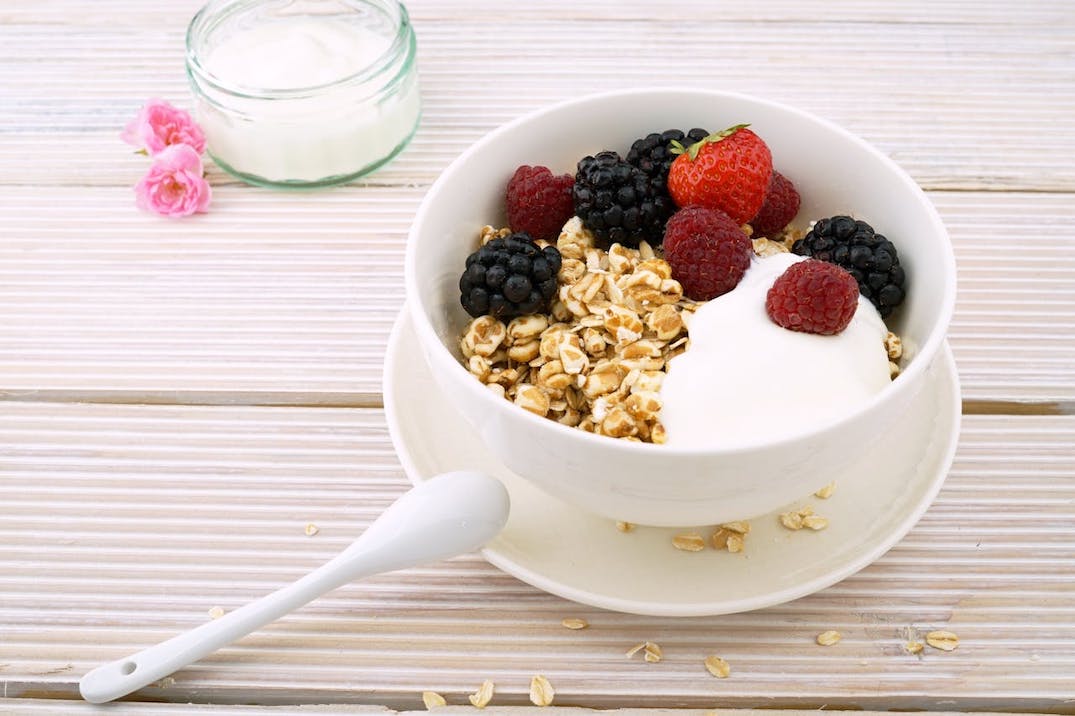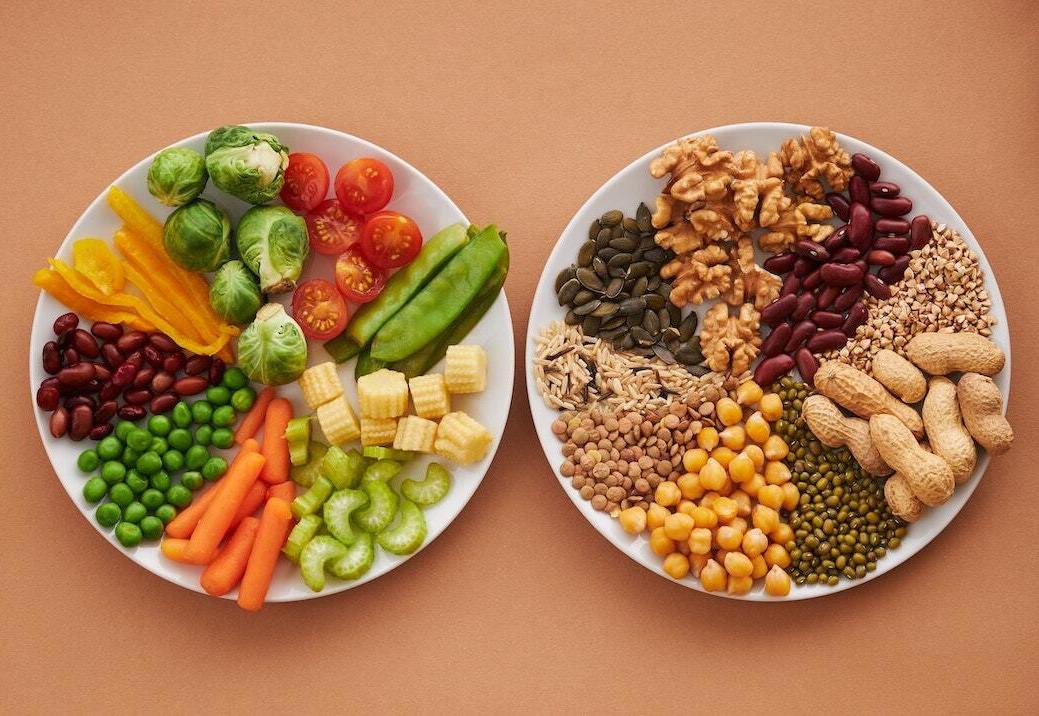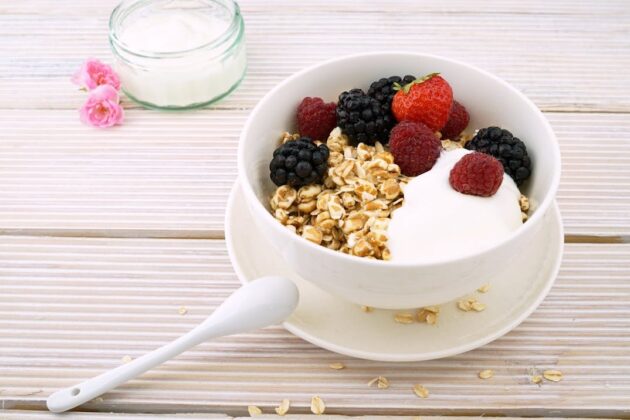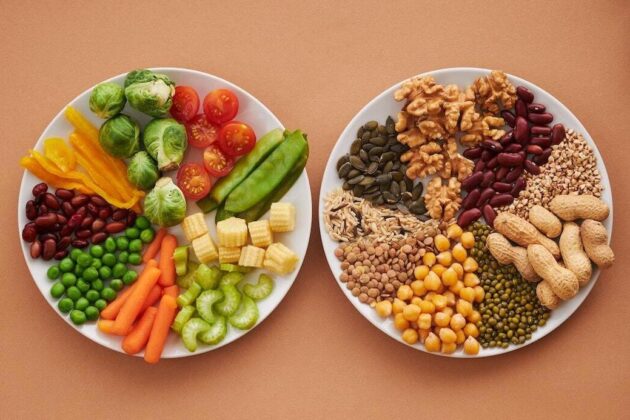Crohn’s Disease Diet Plan: Best Foods, Foods to Avoid, & Specific Diets
Crohn’s disease is a type of inflammatory bowel disease that can affect any part of the digestive tract. The exact cause of Crohn’s disease is unknown, however, researchers believe that a combination of genetic, environmental, and immune factors may play a role.
People living with Crohn’s disease may experience diarrhea, fatigue, fever, abdominal pain and cramping, nausea, appetite loss, weight loss, and sometimes bloody stools. Symptoms of Crohn’s disease can be uncomfortable and interfere with daily life.
Most people with Crohn’s disease benefit from eating foods that are easy for the body to digest and absorb while avoiding foods that cause inflammation or irritate the intestines.
This guide goes over what a healthy diet for Crohn’s disease looks like, including the best foods to eat and which to avoid. We also review the efficacy of specific diets for Crohn’s and provide a sample meal plan, helpful tips, and recommendations for getting support.
Crohn’s disease diet overview
Adjusting your diet can help reduce your symptoms of Crohn’s disease. Researchers have studied several different diets to help determine the best diet for Crohn’s. The diet that works best for you depends on your symptoms and which area of your digestive tract is affected.
A diet for Crohn’s disease often avoids foods that cause or worsen symptoms. For some people, this means avoiding certain fruits and vegetables, fatty meats, and dairy products. Other people may need to follow an elimination diet to identify specific foods that trigger symptoms.
Foods that may help with Crohn’s disease include lean proteins and healthy fats to help reduce inflammation. Certain types of carbohydrates that are easy for the body to digest and absorb may also help reduce symptoms.
Certain fruits and vegetables can be made more tolerable by how they are prepared. Cooking vegetables until they are fork-tender makes it easier for your body to digest. Removing the skins, peels, and seeds may also make certain fruits and vegetables more tolerable.
Best foods to eat for Crohn’s disease
There is a lot of research on what foods are best to eat with Crohn’s disease. Typically, it is best to choose easy-to-digest foods, such as those low in fiber and low in fat. However, individual tolerance varies. Ideas for foods to eat include (but are not limited to):
- Fruits with low insoluble fiber. Insoluble fiber can increase the amount of water in your intestines, causing food to digest quickly. This can trigger or worsen diarrhea. Insoluble fiber does not dissolve in water. So, if a fruit dissolves in water, this is a sign that it is low in insoluble fiber. Applesauce, ripe bananas, canned fruits, cantaloupe, nectarines, and raspberries are low in insoluble fiber compared to other fruits and are tolerated by most people with Crohn’s.
- Vegetables with low insoluble fiber. As with fruits, it is best to choose certain vegetables that do not contain high amounts of insoluble fiber. Beets, carrots, pumpkin, squash, green beans, and wax beans are typically well-tolerated.
- Cooked vegetables. Raw vegetables are difficult for your body to break down, often causing uncomfortable bloating and gas. To make vegetables more tolerable, cook vegetables until they are fork-tender.
- Foods that are high in omega-3 fatty acids. Omega-3 fatty acids may help reduce intestinal inflammation in patients with Crohn’s disease. Walnut butter, flaxseed oil, and fatty fish such as salmon, mackerel, and herring are great sources of omega-3 fatty acids.
- Resistant starches. Resistant starches are a type of carbohydrate that does not digest in the small intestine. Instead, they are fermented in the large intestine, which means they feed the “good” bacteria in your gut. Clinical trials have shown that consuming resistant starches may lead to improvements in diarrhea, constipation, and tissue repair in some individuals with inflammatory bowel disease. Food sources of resistant starches include potatoes, plantains, legumes, oatmeal, cornmeal, gluten-free bread, and rice.
- Lean proteins. Consuming enough protein each day helps repair and build your body’s tissues and promote the healing process. Choose lean sources of protein, such as chicken breast, fish, turkey, tofu, and eggs to consume enough protein each day without aggravating symptoms caused by high-fat proteins.
- Dairy alternatives. Current research is mixed on the effect that dairy has on people with Crohn’s disease. Some people with Crohn’s disease avoid dairy because they find it triggers symptoms. Dairy substitutes include products made from almonds, soy, coconut, and flaxseed.
- Non-spicy flavors and seasonings. Spicy foods often trigger or aggravate symptoms of Crohn’s disease. To add more flavor to your food without the extra heat, try adding spices such as turmeric, ginger, oregano, cumin, chives, and fresh herbs.
- Nut butters. Peanut butter, almond butter, and cashew butter are great sources of healthy fats and protein. To avoid issues with digesting nut pieces, choose smooth nut butters over chunky ones.

Improve your gut health with support from a Registered Dietitian
90% of Zaya Care patients pay $0 for dietitian visits
Foods to avoid with Crohn’s disease
Avoiding foods that trigger your symptoms is an important part of managing Crohn’s disease. Tolerance of certain foods varies among individuals, so it is important to understand what works for you. Foods that may need to be avoided include:
- Whole grains. Whole grains are often recommended to the general healthy population because of their high fiber and nutrient content. However, a person with Crohn’s disease may need to avoid whole grains as they may trigger symptoms. Whole grains include brown rice, quinoa, oatmeal, and whole grain products such as cereal, bread, and pasta.
- High-fiber vegetables. Vegetables contain important nutrients that provide a variety of health benefits, so they should not be completely eliminated from your diet. To avoid eating too much fiber, eliminate high-fiber vegetables such as artichokes, peas, lima beans, Brussels sprouts, broccoli, cauliflower, and cabbage.
- High-fiber fruits. Fruits also contain key nutrients that you do not want to miss out on. Instead of eliminating all fruits, try avoiding fruits with high amounts of fiber per serving. High-fiber fruits to be cautious with include berries, pears, prunes, dates, and raisins.
- Vegetable and fruit skins. The skins of vegetables and fruit are typically higher in insoluble fiber, which may worsen symptoms. To avoid consuming too much insoluble fiber, remove the skins of fruits and vegetables like apples, kiwis, peaches, potatoes, eggplant, and zucchini.
- Other high-fiber foods. Other high-fiber foods, such as beans and lentils, should be avoided while you are experiencing symptoms of Crohn’s disease to prevent further irritation of the intestines.
- Fatty foods and greasy foods. Fatty foods and greasy foods are not well-absorbed and can lead to symptoms such as abdominal cramping and diarrhea. Fatty and greasy foods, such as fried foods, cream, butter, oils, cheeseburgers, pizza, sausage, bacon, and hot dogs should also be avoided.
- Foods and drinks with lactose. Dairy foods such as milk, cheese, cream, and butter all contain lactose and may exacerbate symptoms of inflammatory bowel disease. However, not everyone with Crohn’s must avoid dairy. Depending on your situation, you may need to choose lactose-free alternatives to avoid triggering symptoms.
- Spicy foods and spices. Spicy foods can trigger or worsen symptoms of Crohn’s disease. Avoids spicy foods and condiments, such as hot sauces, hot peppers, and cayenne pepper.
- Candy and other sugary foods. While experiencing symptoms, it is recommended to eliminate sugary foods. Sugar can pull water into your intestines, which may contribute to diarrhea. Avoiding pastries and candy can prevent symptoms like diarrhea from getting worse.
- Alcohol. In some studies, patients with inflammatory bowel disease have reported worse symptoms following alcohol consumption. Alcohol is known to cause dehydration, intestinal inflammation, and medication interactions. If possible, it is best to avoid it altogether.
- Coffee and black tea. Caffeinated beverages such as coffee and black tea can stimulate your intestines and exacerbate symptoms of Crohn’s disease. To avoid triggering symptoms, you may want to choose decaf coffee or herbal teas.
- Soda and other carbonated drinks. Carbonation may cause additional bloating and abdominal discomfort. Soda and other carbonated drinks often contain a combination of ingredients, including sugar and caffeine that can worsen symptoms.
- Highly processed foods. Evidence suggests that highly processed foods promote inflammation. Highly processed foods such as chips, sugary drinks, deli meats, bakery products, sauces, frozen meals, and fast food may contain additives and other ingredients that contribute to intestinal inflammation.
- Sugar alcohols and artificial sweeteners. These sugar substitutes are added to foods like protein bars, sugar-free candy, and diet beverages to provide a sweet taste without added calories. Research shows a possible link between artificial sweeteners and inflammatory bowel disease. Sugar substitutes are hard for the body to absorb, causing digestive upset.
- Nuts and seeds. Consuming nuts and seeds may worsen symptoms because they are harder to digest. If your symptoms are active, it is best not to consume whole nuts and seeds or foods that contain nuts and seeds, such as bread and pastries.
Example Crohn’s disease meal plan
Here is a sample 2,000-calorie Crohn’s disease diet plan that includes many of the best foods to eat listed above while avoiding those that can trigger symptoms. It’s important to consult with your doctor, dietitian, or other healthcare provider before making any drastic diet chances.
Breakfast
- Scrambled eggs (2 large)
- Gluten-free toast (2 slices) with a pat of margarine
- A ripe banana
Mid-Morning Snack
- A smoothie made with lactose-free yogurt, a handful of strawberries, and a ripe banana
Lunch
- Chicken and rice soup (1 cup)
- Gluten-free roll
- Steamed carrots (1/2 cup)
Afternoon Snack
- Rice cakes (2) with almond butter (2 tablespoons)
Dinner
- Baked turkey (4 oz)
- Mashed potatoes made with lactose-free milk and margarine (1 cup)
- Steamed green beans (1/2 cup)
Evening Snack
- Gluten-free toast (1 slice) with a pat of margarine and a drizzle of honey
>> Find a Crohn’s Disease Nutritionist That Accepts Your Insurance
Identifying trigger foods with Crohn’s disease
A trigger food is a specific type of food that, after consumption, causes symptoms to return. Everyone experiences Crohn’s disease differently, and trigger foods vary among individuals. It is important to understand your symptoms and what types of foods cause them or make them worse.
To identify your trigger foods, you need to pay attention to everything you eat and when you experience symptoms. Keeping track of everything you eat in a food diary and documenting when your symptoms recur can help you determine which foods you may need to avoid.
When a trigger food has been identified, it is best to eliminate that food from your diet to prevent symptoms from returning. Once you identify all foods that cause or worsen your symptoms, the goal is to follow a healthy, enjoyable diet that excludes your trigger foods.
Reviewing specific diets for Crohn’s disease and their efficacy
There is no one-size-fits-all when it comes to a diet for Crohn’s disease. What works for one person might not work for another. Below are some diets that have been investigated for their potential role in managing Crohn’s disease.
Low FODMAP diet
“FODMAP” is an acronym that stands for a group of carbohydrates that the body is not able to digest in the small intestine. Instead, they are fermented, or broken down, by bacteria in the large intestine. This fermentation process may result in a build-up of gas, causing discomfort.
A low FODMAP diet is a temporary diet plan where you eliminate “high FODMAP” foods for a certain period. Some fruits and vegetables, beans, lentils, dairy, wheat, rye, nuts, and sweeteners are all eliminated in the first phase. Once your symptoms have resolved, you slowly reintroduce those foods back into your diet.
The low FODMAP diet may help people identify trigger foods and reduce symptoms. However, this diet is challenging to follow due to its restrictive nature. Guidance from a nutrition professional is best to avoid nutrition deficiencies and ensure proper adherence to this diet.
Specific carbohydrate diet
The specific carbohydrate diet is based on the theory that certain carbohydrates are not digested properly in the body. This leads to an increase in harmful bacteria that may damage the intestines. To eliminate harmful bacteria in the gut, this diet only allows carbohydrates that require minimal digestion.
The specific carbohydrate diet eliminates grains, starches, milk products, sugar, and some legumes. Simple carbohydrates, such as fruit, honey, and some vegetables are allowed because they are easy to digest. Protein foods such as fresh meat, poultry, fish, eggs, and nuts are also allowed.
While the specific carbohydrate diet has shown improvements in symptoms, participants in a 2021 study reported that adhering to this diet is difficult. Therefore, other diets may be preferred by people living with Crohn’s disease.
Mediterranean diet
The Mediterranean diet is well-known for its anti-inflammatory effects and heart health. Foods included in this diet provide high amounts of fiber, antioxidants, and healthy fats. This diet focuses on moderation rather than elimination and is less restrictive compared to other diets for Crohn’s disease.
The Mediterranean diet consists of legumes, whole grains, vegetables, fruits, nuts, seeds, fish, and olive oil with moderate amounts of eggs, poultry, and dairy. Consumption of processed foods, added sugars, and red meat is minimal on this diet.
A recent study showed that the Mediterranean diet may improve intestinal inflammation and provide additional health benefits. However, more evidence is needed to examine the benefits of this diet for those with inflammatory bowel disease.
IBD AID
The anti-inflammatory diet for Inflammatory Bowel Disease (IBD AID) is intended to promote a healthy gut microbiome. Foods included are intended to decrease intestinal inflammation and repair the gut. It also includes three phases of texture modification that depend on the severity of symptoms.
Probiotic foods (such as yogurt, kimchi, and kefir) and prebiotic foods (such as bananas, onions, leeks, and asparagus) are emphasized to help balance good and harmful bacteria in the gut. To maintain good nutrition, this diet also allows lean proteins and healthy fats.
Excluded from this diet are certain carbohydrates that are believed to cause inflammation. These include lactose, wheat, refined sugar, and corn. When symptoms are active, only texture-modified foods such as blended or pureed foods are allowed.
Due to various limitations in research, there is a lack of consistent data to support a practical recommendation for this diet. Patients should have an in-depth knowledge of the strengths and limitations of this diet to ensure its effectiveness.
AIP diet
The purpose of the Autoimmune Protocol (AIP) diet is to decrease inflammation in the body by eliminating all foods that may contribute to inflammation. This diet involves both an elimination phase and a reintroduction phase.
Foods eliminated in the first phase are grains, legumes, dairy, eggs, food additives, refined sugar, alcohol, coffee, nuts, seeds, and certain vegetables. Fresh fruit, bone broth, and minimally processed meats are allowed in both phases.
As symptoms resolve, foods that were eliminated are slowly reintroduced. If symptoms return after a certain food is reintroduced, that food is considered a trigger food and should be avoided long-term.
Research on the efficacy of the AIP diet is limited but appears promising for patients with inflammatory bowel disease. Because of its restrictive nature, expert guidance is recommended for this diet to ensure nutrition needs are met.
Gluten-free diet
Gluten is a protein that is naturally found in wheat, rye, and barley. Bread, pastries, pasta, cereal, and crackers all contain gluten. A gluten-free diet avoids all foods that contain gluten. This diet is less restrictive compared to other diets for Crohn’s disease, however, it may not be the most effective for everyone.
Many people with Crohn’s disease avoid gluten because they find it triggers their symptoms. In one study, 42.4% of participants with inflammatory bowel disease self-reported gluten sensitivity. In another study, 65.6% of all participants had improvements in gastrointestinal symptoms while on a gluten-free diet.
However, some people with Crohn’s disease can eat gluten without a problem. Research on gluten and inflammatory bowel disease remains unclear. The efficacy of following a gluten-free diet for improving symptoms appears to vary among individuals.
Crohn’s disease exclusion diet
The idea of the Crohn’s disease exclusion diet is to exclude foods that have pro-inflammatory effects and may cause damage to the gut. It involves partial enteral nutrition, which means it combines a nutrition formula with whole food. This diet is broken up into three six-week phases.
Phase one only allows small amounts of lean meats, some vegetables, and rice. In phase two, certain vegetables, fruits, and some whole grains are reintroduced. In phase three, you reintroduce foods that can potentially be irritating. A liquid formula is allowed during each phase to provide adequate nutrition.
A 2021 study examined the effectiveness of this diet in managing Crohn’s symptoms. After 12 weeks, 82.1% of participants achieved clinical remission, which means their symptoms significantly reduced. The effectiveness of this diet plan depends largely on patient adherence.

Improve your gut health with support from a Registered Dietitian
90% of Zaya Care patients pay $0 for dietitian visits
Tips for a healthy Crohn’s disease diet & lifestyle
Managing symptoms of Crohn’s disease often involves a combination of medication, diet, and lifestyle factors. Individual symptoms vary, so it is best to consult your doctor to determine the best plan for you.
- Hydrate. It can be easy to become dehydrated for people living with Crohn’s disease because of increased fluid loss from diarrhea. To prevent dehydration, it is important to drink plenty of fluids and electrolytes each day to replenish fluids lost.
- Eat smaller, more frequent meals. Large meals may cause you to feel too full and aggravate symptoms. Smaller amounts of food make it easier for the body to digest and absorb essential nutrients. Some people find it helpful to eat five to six smaller meals a day to minimize symptoms.
- Keep a food diary to identify trigger foods. There is no perfect diet for all patients because individual food tolerance varies. Keeping a food diary will help you identify foods that trigger your symptoms and help you understand your specific nutrition needs.
- Practice mindful eating. Mindful eating is an effort to focus on what and how you are eating. Slowing down, eliminating distractions, and appreciating the food you have can help you be more present when you eat. This approach to eating can help improve digestion and lower stress.
- Meal prep. Deciding on what foods to eat on a daily basis can be stressful if you have dietary restrictions. Meal prepping ahead of time can help ensure that you are eating healthy without the added stress of making daily decisions.
- Get plenty of sleep. A recent study revealed that poor sleep quality is associated with more complications and adverse outcomes in patients with Crohn’s disease. It is important to prioritize sleep to help improve disease outcomes and quality of life.
- Exercise regularly. Exercise has been proven to boost mood and reduce stress. For patients with an inflammatory bowel disease, low-to-moderate intensity exercise, such as walking, cycling, and swimming is encouraged. Recent research has also suggested that incorporating resistance training provides additional benefits such as improved body composition and bone mineral loss in Crohn’s disease patients. More research is needed to determine the best recommendations for type, intensity, and amount of physical activity for Crohn’s disease patients.
- Manage stress. Chronic stress can trigger symptoms of Crohn’s disease. Relieving stress through common techniques, such as relaxation exercises and deep breathing, not only can improve symptoms, but also improve your quality of life.
- Avoid smoking. Research shows that Crohn’s disease patients who smoke have higher medical requirements, more disease-related complications, and worse outcomes than those who do not smoke. It is recommended to quit smoking to improve the prognosis of Crohn’s disease.
- Consider supplementation. Managing Crohn’s disease through diet can require several dietary restrictions. You might need to consider taking nutrition supplements to assure that you get all the vitamins and minerals you need. It is best to consult your doctor before taking any supplements.
- Take your medications. There are several different types of medications used for Crohn’s disease that can help get your symptoms under control. These include anti-inflammatory drugs and antibiotics. The medications your doctor prescribes depend on how severe your symptoms are. Taking your medications along with adhering to proper diet and lifestyle habits will help keep Crohn’s disease in remission.
- Work with a Crohn’s disease nutritionist. Managing Crohn’s disease through diet can be challenging. A nutritionist who specializes in inflammatory bowel disease can help you determine the best foods for you to incorporate into your diet to provide key nutrients without aggravating symptoms.
>> Find a Crohn’s Disease Nutritionist That Accepts Your Insurance
Why you should consider working with a Crohn’s disease nutritionist
It is not always easy to know what foods to eat with Crohn’s disease. There are many diets that can potentially treat symptoms, so it is best to talk with a nutrition professional who specializes in inflammatory bowel diseases to determine which diet would be best for you.
Managing symptoms of Crohn’s disease often means following a restrictive diet. Expert guidance and support from a nutritionist might help avoid nutritional inadequacies while maintaining long-term adherence. A nutrition professional can identify key nutrients you may not be getting enough of and the potential need for supplementation.
Working with a nutritionist who understands Crohn’s disease can help you identify your trigger foods and provide the best alternatives. This can help ease the stress of making daily food choices. Working with a nutrition professional is almost worth it as they can create an individualized diet plan that excludes trigger foods, meets your nutrition needs, and is enjoyable to you. This will help you stick with it and have more success with reducing your symptoms.
Here at Zaya Care, we can match you with a Crohn’s disease nutritionist that is covered by your insurance. You can browse our network of nutritionists and filter by things like visit type, languages spoken, insurance accepted, and more to find your fit.

Improve your gut health with support from a Registered Dietitian
90% of Zaya Care patients pay $0 for dietitian visits
Crohn’s disease is a type of inflammatory bowel disease that can affect any part of the digestive tract. The exact cause of Crohn’s disease is unknown, however, researchers believe that a combination of genetic, environmental, and immune factors may play a role.
People living with Crohn’s disease may experience diarrhea, fatigue, fever, abdominal pain and cramping, nausea, appetite loss, weight loss, and sometimes bloody stools. Symptoms of Crohn’s disease can be uncomfortable and interfere with daily life.
Most people with Crohn’s disease benefit from eating foods that are easy for the body to digest and absorb while avoiding foods that cause inflammation or irritate the intestines.
This guide goes over what a healthy diet for Crohn’s disease looks like, including the best foods to eat and which to avoid. We also review the efficacy of specific diets for Crohn’s and provide a sample meal plan, helpful tips, and recommendations for getting support.
Crohn’s disease diet overview
Adjusting your diet can help reduce your symptoms of Crohn’s disease. Researchers have studied several different diets to help determine the best diet for Crohn’s. The diet that works best for you depends on your symptoms and which area of your digestive tract is affected.
A diet for Crohn’s disease often avoids foods that cause or worsen symptoms. For some people, this means avoiding certain fruits and vegetables, fatty meats, and dairy products. Other people may need to follow an elimination diet to identify specific foods that trigger symptoms.
Foods that may help with Crohn’s disease include lean proteins and healthy fats to help reduce inflammation. Certain types of carbohydrates that are easy for the body to digest and absorb may also help reduce symptoms.
Certain fruits and vegetables can be made more tolerable by how they are prepared. Cooking vegetables until they are fork-tender makes it easier for your body to digest. Removing the skins, peels, and seeds may also make certain fruits and vegetables more tolerable.
Best foods to eat for Crohn’s disease
There is a lot of research on what foods are best to eat with Crohn’s disease. Typically, it is best to choose easy-to-digest foods, such as those low in fiber and low in fat. However, individual tolerance varies. Ideas for foods to eat include (but are not limited to):
- Fruits with low insoluble fiber. Insoluble fiber can increase the amount of water in your intestines, causing food to digest quickly. This can trigger or worsen diarrhea. Insoluble fiber does not dissolve in water. So, if a fruit dissolves in water, this is a sign that it is low in insoluble fiber. Applesauce, ripe bananas, canned fruits, cantaloupe, nectarines, and raspberries are low in insoluble fiber compared to other fruits and are tolerated by most people with Crohn’s.
- Vegetables with low insoluble fiber. As with fruits, it is best to choose certain vegetables that do not contain high amounts of insoluble fiber. Beets, carrots, pumpkin, squash, green beans, and wax beans are typically well-tolerated.
- Cooked vegetables. Raw vegetables are difficult for your body to break down, often causing uncomfortable bloating and gas. To make vegetables more tolerable, cook vegetables until they are fork-tender.
- Foods that are high in omega-3 fatty acids. Omega-3 fatty acids may help reduce intestinal inflammation in patients with Crohn’s disease. Walnut butter, flaxseed oil, and fatty fish such as salmon, mackerel, and herring are great sources of omega-3 fatty acids.
- Resistant starches. Resistant starches are a type of carbohydrate that does not digest in the small intestine. Instead, they are fermented in the large intestine, which means they feed the “good” bacteria in your gut. Clinical trials have shown that consuming resistant starches may lead to improvements in diarrhea, constipation, and tissue repair in some individuals with inflammatory bowel disease. Food sources of resistant starches include potatoes, plantains, legumes, oatmeal, cornmeal, gluten-free bread, and rice.
- Lean proteins. Consuming enough protein each day helps repair and build your body’s tissues and promote the healing process. Choose lean sources of protein, such as chicken breast, fish, turkey, tofu, and eggs to consume enough protein each day without aggravating symptoms caused by high-fat proteins.
- Dairy alternatives. Current research is mixed on the effect that dairy has on people with Crohn’s disease. Some people with Crohn’s disease avoid dairy because they find it triggers symptoms. Dairy substitutes include products made from almonds, soy, coconut, and flaxseed.
- Non-spicy flavors and seasonings. Spicy foods often trigger or aggravate symptoms of Crohn’s disease. To add more flavor to your food without the extra heat, try adding spices such as turmeric, ginger, oregano, cumin, chives, and fresh herbs.
- Nut butters. Peanut butter, almond butter, and cashew butter are great sources of healthy fats and protein. To avoid issues with digesting nut pieces, choose smooth nut butters over chunky ones.

Improve your gut health with support from a Registered Dietitian
90% of Zaya Care patients pay $0 for dietitian visits
Foods to avoid with Crohn’s disease
Avoiding foods that trigger your symptoms is an important part of managing Crohn’s disease. Tolerance of certain foods varies among individuals, so it is important to understand what works for you. Foods that may need to be avoided include:
- Whole grains. Whole grains are often recommended to the general healthy population because of their high fiber and nutrient content. However, a person with Crohn’s disease may need to avoid whole grains as they may trigger symptoms. Whole grains include brown rice, quinoa, oatmeal, and whole grain products such as cereal, bread, and pasta.
- High-fiber vegetables. Vegetables contain important nutrients that provide a variety of health benefits, so they should not be completely eliminated from your diet. To avoid eating too much fiber, eliminate high-fiber vegetables such as artichokes, peas, lima beans, Brussels sprouts, broccoli, cauliflower, and cabbage.
- High-fiber fruits. Fruits also contain key nutrients that you do not want to miss out on. Instead of eliminating all fruits, try avoiding fruits with high amounts of fiber per serving. High-fiber fruits to be cautious with include berries, pears, prunes, dates, and raisins.
- Vegetable and fruit skins. The skins of vegetables and fruit are typically higher in insoluble fiber, which may worsen symptoms. To avoid consuming too much insoluble fiber, remove the skins of fruits and vegetables like apples, kiwis, peaches, potatoes, eggplant, and zucchini.
- Other high-fiber foods. Other high-fiber foods, such as beans and lentils, should be avoided while you are experiencing symptoms of Crohn’s disease to prevent further irritation of the intestines.
- Fatty foods and greasy foods. Fatty foods and greasy foods are not well-absorbed and can lead to symptoms such as abdominal cramping and diarrhea. Fatty and greasy foods, such as fried foods, cream, butter, oils, cheeseburgers, pizza, sausage, bacon, and hot dogs should also be avoided.
- Foods and drinks with lactose. Dairy foods such as milk, cheese, cream, and butter all contain lactose and may exacerbate symptoms of inflammatory bowel disease. However, not everyone with Crohn’s must avoid dairy. Depending on your situation, you may need to choose lactose-free alternatives to avoid triggering symptoms.
- Spicy foods and spices. Spicy foods can trigger or worsen symptoms of Crohn’s disease. Avoids spicy foods and condiments, such as hot sauces, hot peppers, and cayenne pepper.
- Candy and other sugary foods. While experiencing symptoms, it is recommended to eliminate sugary foods. Sugar can pull water into your intestines, which may contribute to diarrhea. Avoiding pastries and candy can prevent symptoms like diarrhea from getting worse.
- Alcohol. In some studies, patients with inflammatory bowel disease have reported worse symptoms following alcohol consumption. Alcohol is known to cause dehydration, intestinal inflammation, and medication interactions. If possible, it is best to avoid it altogether.
- Coffee and black tea. Caffeinated beverages such as coffee and black tea can stimulate your intestines and exacerbate symptoms of Crohn’s disease. To avoid triggering symptoms, you may want to choose decaf coffee or herbal teas.
- Soda and other carbonated drinks. Carbonation may cause additional bloating and abdominal discomfort. Soda and other carbonated drinks often contain a combination of ingredients, including sugar and caffeine that can worsen symptoms.
- Highly processed foods. Evidence suggests that highly processed foods promote inflammation. Highly processed foods such as chips, sugary drinks, deli meats, bakery products, sauces, frozen meals, and fast food may contain additives and other ingredients that contribute to intestinal inflammation.
- Sugar alcohols and artificial sweeteners. These sugar substitutes are added to foods like protein bars, sugar-free candy, and diet beverages to provide a sweet taste without added calories. Research shows a possible link between artificial sweeteners and inflammatory bowel disease. Sugar substitutes are hard for the body to absorb, causing digestive upset.
- Nuts and seeds. Consuming nuts and seeds may worsen symptoms because they are harder to digest. If your symptoms are active, it is best not to consume whole nuts and seeds or foods that contain nuts and seeds, such as bread and pastries.
Example Crohn’s disease meal plan
Here is a sample 2,000-calorie Crohn’s disease diet plan that includes many of the best foods to eat listed above while avoiding those that can trigger symptoms. It’s important to consult with your doctor, dietitian, or other healthcare provider before making any drastic diet chances.
Breakfast
- Scrambled eggs (2 large)
- Gluten-free toast (2 slices) with a pat of margarine
- A ripe banana
Mid-Morning Snack
- A smoothie made with lactose-free yogurt, a handful of strawberries, and a ripe banana
Lunch
- Chicken and rice soup (1 cup)
- Gluten-free roll
- Steamed carrots (1/2 cup)
Afternoon Snack
- Rice cakes (2) with almond butter (2 tablespoons)
Dinner
- Baked turkey (4 oz)
- Mashed potatoes made with lactose-free milk and margarine (1 cup)
- Steamed green beans (1/2 cup)
Evening Snack
- Gluten-free toast (1 slice) with a pat of margarine and a drizzle of honey
>> Find a Crohn’s Disease Nutritionist That Accepts Your Insurance
Identifying trigger foods with Crohn’s disease
A trigger food is a specific type of food that, after consumption, causes symptoms to return. Everyone experiences Crohn’s disease differently, and trigger foods vary among individuals. It is important to understand your symptoms and what types of foods cause them or make them worse.
To identify your trigger foods, you need to pay attention to everything you eat and when you experience symptoms. Keeping track of everything you eat in a food diary and documenting when your symptoms recur can help you determine which foods you may need to avoid.
When a trigger food has been identified, it is best to eliminate that food from your diet to prevent symptoms from returning. Once you identify all foods that cause or worsen your symptoms, the goal is to follow a healthy, enjoyable diet that excludes your trigger foods.
Reviewing specific diets for Crohn’s disease and their efficacy
There is no one-size-fits-all when it comes to a diet for Crohn’s disease. What works for one person might not work for another. Below are some diets that have been investigated for their potential role in managing Crohn’s disease.
Low FODMAP diet
“FODMAP” is an acronym that stands for a group of carbohydrates that the body is not able to digest in the small intestine. Instead, they are fermented, or broken down, by bacteria in the large intestine. This fermentation process may result in a build-up of gas, causing discomfort.
A low FODMAP diet is a temporary diet plan where you eliminate “high FODMAP” foods for a certain period. Some fruits and vegetables, beans, lentils, dairy, wheat, rye, nuts, and sweeteners are all eliminated in the first phase. Once your symptoms have resolved, you slowly reintroduce those foods back into your diet.
The low FODMAP diet may help people identify trigger foods and reduce symptoms. However, this diet is challenging to follow due to its restrictive nature. Guidance from a nutrition professional is best to avoid nutrition deficiencies and ensure proper adherence to this diet.
Specific carbohydrate diet
The specific carbohydrate diet is based on the theory that certain carbohydrates are not digested properly in the body. This leads to an increase in harmful bacteria that may damage the intestines. To eliminate harmful bacteria in the gut, this diet only allows carbohydrates that require minimal digestion.
The specific carbohydrate diet eliminates grains, starches, milk products, sugar, and some legumes. Simple carbohydrates, such as fruit, honey, and some vegetables are allowed because they are easy to digest. Protein foods such as fresh meat, poultry, fish, eggs, and nuts are also allowed.
While the specific carbohydrate diet has shown improvements in symptoms, participants in a 2021 study reported that adhering to this diet is difficult. Therefore, other diets may be preferred by people living with Crohn’s disease.
Mediterranean diet
The Mediterranean diet is well-known for its anti-inflammatory effects and heart health. Foods included in this diet provide high amounts of fiber, antioxidants, and healthy fats. This diet focuses on moderation rather than elimination and is less restrictive compared to other diets for Crohn’s disease.
The Mediterranean diet consists of legumes, whole grains, vegetables, fruits, nuts, seeds, fish, and olive oil with moderate amounts of eggs, poultry, and dairy. Consumption of processed foods, added sugars, and red meat is minimal on this diet.
A recent study showed that the Mediterranean diet may improve intestinal inflammation and provide additional health benefits. However, more evidence is needed to examine the benefits of this diet for those with inflammatory bowel disease.
IBD AID
The anti-inflammatory diet for Inflammatory Bowel Disease (IBD AID) is intended to promote a healthy gut microbiome. Foods included are intended to decrease intestinal inflammation and repair the gut. It also includes three phases of texture modification that depend on the severity of symptoms.
Probiotic foods (such as yogurt, kimchi, and kefir) and prebiotic foods (such as bananas, onions, leeks, and asparagus) are emphasized to help balance good and harmful bacteria in the gut. To maintain good nutrition, this diet also allows lean proteins and healthy fats.
Excluded from this diet are certain carbohydrates that are believed to cause inflammation. These include lactose, wheat, refined sugar, and corn. When symptoms are active, only texture-modified foods such as blended or pureed foods are allowed.
Due to various limitations in research, there is a lack of consistent data to support a practical recommendation for this diet. Patients should have an in-depth knowledge of the strengths and limitations of this diet to ensure its effectiveness.
AIP diet
The purpose of the Autoimmune Protocol (AIP) diet is to decrease inflammation in the body by eliminating all foods that may contribute to inflammation. This diet involves both an elimination phase and a reintroduction phase.
Foods eliminated in the first phase are grains, legumes, dairy, eggs, food additives, refined sugar, alcohol, coffee, nuts, seeds, and certain vegetables. Fresh fruit, bone broth, and minimally processed meats are allowed in both phases.
As symptoms resolve, foods that were eliminated are slowly reintroduced. If symptoms return after a certain food is reintroduced, that food is considered a trigger food and should be avoided long-term.
Research on the efficacy of the AIP diet is limited but appears promising for patients with inflammatory bowel disease. Because of its restrictive nature, expert guidance is recommended for this diet to ensure nutrition needs are met.
Gluten-free diet
Gluten is a protein that is naturally found in wheat, rye, and barley. Bread, pastries, pasta, cereal, and crackers all contain gluten. A gluten-free diet avoids all foods that contain gluten. This diet is less restrictive compared to other diets for Crohn’s disease, however, it may not be the most effective for everyone.
Many people with Crohn’s disease avoid gluten because they find it triggers their symptoms. In one study, 42.4% of participants with inflammatory bowel disease self-reported gluten sensitivity. In another study, 65.6% of all participants had improvements in gastrointestinal symptoms while on a gluten-free diet.
However, some people with Crohn’s disease can eat gluten without a problem. Research on gluten and inflammatory bowel disease remains unclear. The efficacy of following a gluten-free diet for improving symptoms appears to vary among individuals.
Crohn’s disease exclusion diet
The idea of the Crohn’s disease exclusion diet is to exclude foods that have pro-inflammatory effects and may cause damage to the gut. It involves partial enteral nutrition, which means it combines a nutrition formula with whole food. This diet is broken up into three six-week phases.
Phase one only allows small amounts of lean meats, some vegetables, and rice. In phase two, certain vegetables, fruits, and some whole grains are reintroduced. In phase three, you reintroduce foods that can potentially be irritating. A liquid formula is allowed during each phase to provide adequate nutrition.
A 2021 study examined the effectiveness of this diet in managing Crohn’s symptoms. After 12 weeks, 82.1% of participants achieved clinical remission, which means their symptoms significantly reduced. The effectiveness of this diet plan depends largely on patient adherence.

Improve your gut health with support from a Registered Dietitian
90% of Zaya Care patients pay $0 for dietitian visits
Tips for a healthy Crohn’s disease diet & lifestyle
Managing symptoms of Crohn’s disease often involves a combination of medication, diet, and lifestyle factors. Individual symptoms vary, so it is best to consult your doctor to determine the best plan for you.
- Hydrate. It can be easy to become dehydrated for people living with Crohn’s disease because of increased fluid loss from diarrhea. To prevent dehydration, it is important to drink plenty of fluids and electrolytes each day to replenish fluids lost.
- Eat smaller, more frequent meals. Large meals may cause you to feel too full and aggravate symptoms. Smaller amounts of food make it easier for the body to digest and absorb essential nutrients. Some people find it helpful to eat five to six smaller meals a day to minimize symptoms.
- Keep a food diary to identify trigger foods. There is no perfect diet for all patients because individual food tolerance varies. Keeping a food diary will help you identify foods that trigger your symptoms and help you understand your specific nutrition needs.
- Practice mindful eating. Mindful eating is an effort to focus on what and how you are eating. Slowing down, eliminating distractions, and appreciating the food you have can help you be more present when you eat. This approach to eating can help improve digestion and lower stress.
- Meal prep. Deciding on what foods to eat on a daily basis can be stressful if you have dietary restrictions. Meal prepping ahead of time can help ensure that you are eating healthy without the added stress of making daily decisions.
- Get plenty of sleep. A recent study revealed that poor sleep quality is associated with more complications and adverse outcomes in patients with Crohn’s disease. It is important to prioritize sleep to help improve disease outcomes and quality of life.
- Exercise regularly. Exercise has been proven to boost mood and reduce stress. For patients with an inflammatory bowel disease, low-to-moderate intensity exercise, such as walking, cycling, and swimming is encouraged. Recent research has also suggested that incorporating resistance training provides additional benefits such as improved body composition and bone mineral loss in Crohn’s disease patients. More research is needed to determine the best recommendations for type, intensity, and amount of physical activity for Crohn’s disease patients.
- Manage stress. Chronic stress can trigger symptoms of Crohn’s disease. Relieving stress through common techniques, such as relaxation exercises and deep breathing, not only can improve symptoms, but also improve your quality of life.
- Avoid smoking. Research shows that Crohn’s disease patients who smoke have higher medical requirements, more disease-related complications, and worse outcomes than those who do not smoke. It is recommended to quit smoking to improve the prognosis of Crohn’s disease.
- Consider supplementation. Managing Crohn’s disease through diet can require several dietary restrictions. You might need to consider taking nutrition supplements to assure that you get all the vitamins and minerals you need. It is best to consult your doctor before taking any supplements.
- Take your medications. There are several different types of medications used for Crohn’s disease that can help get your symptoms under control. These include anti-inflammatory drugs and antibiotics. The medications your doctor prescribes depend on how severe your symptoms are. Taking your medications along with adhering to proper diet and lifestyle habits will help keep Crohn’s disease in remission.
- Work with a Crohn’s disease nutritionist. Managing Crohn’s disease through diet can be challenging. A nutritionist who specializes in inflammatory bowel disease can help you determine the best foods for you to incorporate into your diet to provide key nutrients without aggravating symptoms.
>> Find a Crohn’s Disease Nutritionist That Accepts Your Insurance
Why you should consider working with a Crohn’s disease nutritionist
It is not always easy to know what foods to eat with Crohn’s disease. There are many diets that can potentially treat symptoms, so it is best to talk with a nutrition professional who specializes in inflammatory bowel diseases to determine which diet would be best for you.
Managing symptoms of Crohn’s disease often means following a restrictive diet. Expert guidance and support from a nutritionist might help avoid nutritional inadequacies while maintaining long-term adherence. A nutrition professional can identify key nutrients you may not be getting enough of and the potential need for supplementation.
Working with a nutritionist who understands Crohn’s disease can help you identify your trigger foods and provide the best alternatives. This can help ease the stress of making daily food choices. Working with a nutrition professional is almost worth it as they can create an individualized diet plan that excludes trigger foods, meets your nutrition needs, and is enjoyable to you. This will help you stick with it and have more success with reducing your symptoms.
Here at Zaya Care, we can match you with a Crohn’s disease nutritionist that is covered by your insurance. You can browse our network of nutritionists and filter by things like visit type, languages spoken, insurance accepted, and more to find your fit.

Improve your gut health with support from a Registered Dietitian
90% of Zaya Care patients pay $0 for dietitian visits
















